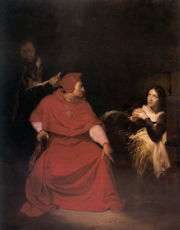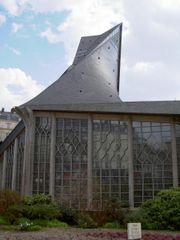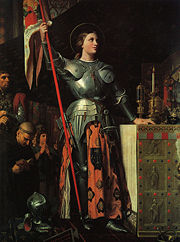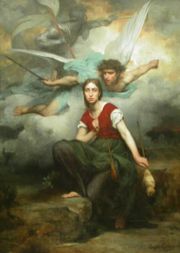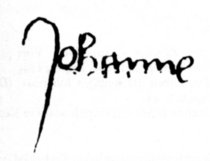Joan of Arc
2008/9 Schools Wikipedia Selection. Related subjects: Military People
| Saint Joan of Arc (Jeanne d'Arc) | |
|---|---|
| Painting, c.1485. Artist's interpretation; the only portrait for which she is known to have sat has not survived. (Centre Historique des Archives Nationales, Paris, AE II 2490) | |
| Virgin | |
| Born | c. 1412, Domrémy, France |
| Died | May 30, 1431, Rouen, France |
| Venerated in | Roman Catholic Church |
| Beatified | April 18, 1909, Notre Dame Cathedral by Pius X |
| Canonized | May 16, 1920, St. Peter's Basilica, Rome by Benedict XV |
| Feast | May 30 |
| Attributes | Virgin |
| Patronage | France; martyrs; captives; militants; people ridiculed for their piety; prisoners; rape victims (though she was not raped); soldiers; Women Appointed for Voluntary Emergency Service; Women's Army Corps |
Joan of Arc, or Jehanne d'Arc in French, (c. 1412 – May 30, 1431) also known as "the Maid of Orleans", was a 15th century virgin saint and national heroine of France. A peasant girl born in Eastern France, Joan led the French army to several important victories during the Hundred Years' War, claiming divine guidance, and was indirectly responsible for the coronation of King Charles VII. She was captured by the English and tried by an ecclesiastical court led by Bishop Pierre Cauchon, an English partisan; the court convicted her of heresy and she was burned at the stake by the English when she was nineteen years old. Twenty-four years later, the Holy See reviewed the decision of the ecclesiastical court, found her innocent, and declared her a martyr. She was beatified in 1909 and later canonized in 1920.
Joan asserted that she had visions from God that told her to recover her homeland from English domination late in the Hundred Years' War. The uncrowned King Charles VII sent her to the siege at Orléans as part of a relief mission. She gained prominence when she overcame the dismissive attitude of veteran commanders and lifted the siege in only nine days. Several more swift victories led to Charles VII's coronation at Reims and settled the disputed succession to the throne.
The renewed French confidence outlasted her own brief career. She refused to leave the field when she was wounded during an attempt to recapture Paris that autumn. Hampered by court intrigues, she led only minor companies from then onward and fell prisoner at a skirmish near Compiègne the following spring. A politically motivated trial convicted her of heresy. The English regent John of Lancaster, 1st Duke of Bedford had her burnt at the stake in Rouen. She had been the heroine of her country at 17 and died when only 19 years old. Some 24 years later, Pope Callixtus III reopened the case, and a new finding overturned the original conviction. Her piety to the end impressed the retrial court. She was beatified in the 20th century, and Pope Benedict XV canonized her on May 16, 1920.
Joan of Arc has remained an important figure throughout Western culture. From Napoleon to the present, French politicians of all leanings have invoked her memory. Major writers and composers who have created works about her include Shakespeare, Voltaire, Schiller, Verdi, Tchaikovsky, Twain, and Shaw. Depictions of her continue in film, television, song, and dance.
Background
The historian Kelly DeVries describes the period preceding her appearance with, "If anything could have discouraged her, the state of France in 1429 should have." The Hundred Years' War had begun in 1337 as a succession dispute to the French throne with intermittent periods of relative peace. Nearly all the fighting had taken place in France, and the English use of chevauchée tactics had devastated the economy. The French population had not recovered from the Black Death of the previous century and its merchants were cut off from foreign markets. At the outset of her career, the English had almost achieved their goal of a dual monarchy under English control and the French army had won no major victory for a generation. In DeVries's words, "the kingdom of France was not even a shadow of its thirteenth-century prototype."
The French king at the time of Joan's birth, Charles VI, suffered bouts of insanity and was often unable to rule. The king's brother Duke Louis of Orléans and the king's cousin John the Fearless, Duke of Burgundy, quarreled over the regency of France and the guardianship of the royal children. This dispute escalated to accusations of an extramarital affair with Queen Isabeau of Bavaria and the kidnappings of the royal children. The matter climaxed when the Duke of Burgundy ordered the assassination of the Duke of Orléans in 1407.
The factions loyal to these two men became known as the Armagnacs and the Burgundians. The English king, Henry V, took advantage of this turmoil to invade France, winning a dramatic victory at Agincourt in 1415, and capturing northern French towns. The future French king, Charles VII, assumed the title of Dauphin as heir to the throne at the age of 14, after all four of his older brothers died. His first significant official act was to conclude a peace treaty with Burgundy in 1419. This ended in disaster when Armagnac partisans murdered John the Fearless during a meeting under Charles's guarantee of protection. The new Duke of Burgundy, Philip the Good, blamed Charles and entered into an alliance with the English. Large sections of France were conquered.
In 1420, Queen Isabeau of Bavaria concluded the Treaty of Troyes, which granted the French royal succession to Henry V and his heirs in preference to her son Charles. This agreement revived rumors about her supposed affair with the late duke of Orléans and raised fresh suspicions that the Dauphin was a royal bastard rather than the son of the king. Henry V and Charles VI died within two months of each other in 1422, leaving an infant, Henry VI of England, the nominal monarch of both kingdoms. Henry V's brother, John of Lancaster, 1st Duke of Bedford, acted as regent.
By the beginning of 1429, nearly all of northern France and some parts of the southwest were under foreign control. The English ruled Paris, while the Burgundians controlled Reims. The latter city was important as the traditional site of French coronations and consecrations, especially since neither claimant to the throne of France had yet been crowned. The English had laid siege to Orléans, which was the only remaining loyal French city north of the Loire. Its strategic location along the river made it the last obstacle to an assault on the remainder of the French heartland. In the words of one modern historian, "On the fate of Orléans hung that of the entire kingdom." No one was optimistic that the city could long withstand the siege.
Life
Joan of Arc's parents' names were Jacques d'Arc and Isabelle Romée in Domrémy, a village which was then in the duchy of Bar (and later annexed to the province of Lorraine and renamed Domrémy-la-Pucelle). Her parents owned about 50 acres (0.2 square kilometers) of land and her father supplemented his farming work with a minor position as a village official, collecting taxes and heading the local watch. They lived in an isolated patch of northeastern territory that remained loyal to the French crown despite being surrounded by Burgundian lands. Several local raids occurred during her childhood and on one occasion her village was burned.
Joan said she was about 19 at her trial, so she was born about 1412; she later testified that she experienced her first vision around 1424 at the age of 12 years when she was out alone in a field and heard voices. She had said she cried when they left as they were so beautiful. She would report that Saint Michael, Saint Catherine, and Saint Margaret told her to drive out the English and bring the Dauphin to Reims for his coronation.
At the age of 16, she asked a kinsman, Durand Lassois, to bring her to nearby Vaucouleurs where she petitioned the garrison commander, Count Robert de Baudricourt, for permission to visit the royal French court at Chinon. Baudricourt's sarcastic response did not deter her. She returned the following January and gained support from two men of standing: Jean de Metz and Bertrand de Poulengy. Under their auspices, she gained a second interview where she made a remarkable prediction about a military reversal near Orléans.
Rise
Robert de Baudricourt granted her an escort to visit Chinon after news from the front confirmed her prediction. She made the journey through hostile Burgundian territory in male disguise. Upon arriving at the royal court she impressed Charles VII during a private conference. He then ordered background inquiries and a theological examination at Poitiers to verify her morality. During this time Charles's mother-in-law Yolande of Aragon was financing a relief expedition to Orléans. Joan petitioned for permission to travel with the army and wear the equipment of a knight. She depended on donated items for her armour, horse, sword, banner, and entourage. Her armor was said to be white. Historian Stephen W. Richey explains her attraction as the only source of hope for a regime that was near collapse:
| “ | After years of one humiliating defeat after another, both the military and civil leadership of France were demoralized and discredited. When the Dauphin Charles granted Joan’s urgent request to be equipped for war and placed at the head of his army, his decision must have been based in large part on the knowledge that every orthodox, every rational, option had been tried and had failed. Only a regime in the final straits of desperation would pay any heed to an illiterate farm girl who claimed that the voice of God was instructing her to take charge of her country’s army and lead it to victory. | ” |
| "King of England, and you, duke of Bedford, who call yourself regent of the kingdom of France...settle your debt to the king of Heaven; return to the Maiden, who is envoy of the king of Heaven, the keys to all the good towns you took and violated in France." |
| Her Letter to the English, March–April 1429; Quicherat I, p. 240, trans. Wikipedia. |
She arrived at the siege of Orléans on April 29, 1429, but Jean d'Orléans, the acting head of the Orléans ducal family, initially excluded her from war councils and failed to inform her when the army engaged the enemy. This did not prevent her from being present at most councils and battles. The extent of her actual military leadership is a subject of historical debate. Traditional historians such as Édouard Perroy conclude that she was a standard bearer whose primary effect was on morale. This type of analysis usually relies on the condemnation trial testimony, where she stated that she preferred her standard to her sword. Recent scholarship that focuses on the nullification trial testimony asserts that her fellow officers esteemed her as a skilled tactician and a successful strategist. Stephen W. Richey's opinion is one example: "She proceeded to lead the army in an astounding series of victories that reversed the tide of the war." In either case, historians agree that the army enjoyed remarkable success during her brief career.
Leadership
She defied the cautious strategy that had characterized French leadership. During the five months of siege before her arrival, the defenders of Orléans had attempted only one aggressive move and that had ended in disaster. On May 4 the French attacked and captured the outlying fortress of Saint Loup, which she followed on May 5 with a march to a second fortress called Saint Jean le Blanc. Finding it deserted, this became a bloodless victory. The next day she opposed Jean d'Orleans at a war council where she demanded another assault on the enemy. D'Orleans ordered the city gates locked to prevent another battle, but she summoned the townsmen and common soldiers and forced the mayor to unlock a gate. With the aid of only one captain she rode out and captured the fortress of Saint Augustins. That evening she learned she had been excluded from a war council where the leaders had decided to wait for reinforcements before acting again. Disregarding this decision, she insisted on assaulting the main English stronghold called "les Tourelles" on May 7. Contemporaries acknowledged her as the heroine of the engagement after she sustained an arrow wound to her neck but returned wounded to lead the final charge.
| "...the Maiden lets you know that here, in eight days, she has chased the English out of all the places they held on the river Loire by attack or other means: they are dead or prisoners or discouraged in battle. Believe what you have heard about the earl of Suffolk, the lord la Pole and his brother, the lord Talbot, the lord Scales, and Sir Fastolf; many more knights and captains than these are defeated." |
| Her Letter to the citizens of Tournai, June 25, 1429; Quicherat V, pp. 125–126, trans. Wikipedia. |
The sudden victory at Orléans led to many proposals for offensive action. The English expected an attempt to recapture Paris or an attack on Normandy. In the aftermath of the unexpected victory, she persuaded Charles VII to grant her co-command of the army with Duke John II of Alençon and gained royal permission for her plan to recapture nearby bridges along the Loire as a prelude to an advance on Reims and a coronation. Hers was a bold proposal because Reims was roughly twice as far away as Paris and deep in enemy territory.
The army recovered Jargeau on June 12, Meung-sur-Loire on June 15, then Beaugency on June 17. The Duke of Alençon agreed to all of Joan's decisions. Other commanders including Jean d'Orléans had been impressed with her performance at Orléans and became her supporters. Alençon credited her for saving his life at Jargeau, where she warned him of an imminent artillery attack. During the same battle she withstood a blow from a stone cannonball to her helmet as she climbed a scaling ladder. An expected English relief force arrived in the area on June 18 under the command of Sir John Fastolf. The battle at Patay might be compared to Agincourt in reverse. The French vanguard attacked before the English archers could finish defensive preparations. A rout ensued that devastated the main body of the English army and killed or captured most of its commanders. Fastolf escaped with a small band of soldiers and became the scapegoat for the English humiliation. The French suffered minimal losses.
The French army set out for Reims from Gien-sur-Loire on June 29 and accepted the conditional surrender of the Burgundian-held city of Auxerre on July 3. Every other town in their path returned to French allegiance without resistance. Troyes, the site of the treaty that had tried to disinherit Charles VII, capitulated after a bloodless four-day siege. The army was in short supply of food by the time it reached Troyes. Edward Lucie-Smith cites this as an example of why she was more lucky than skilled: a wandering friar named Brother Richard had been preaching about the end of the world at Troyes and had convinced local residents to plant beans, a crop with an early harvest. The hungry army arrived as the beans ripened.
| "Prince of Burgundy, I pray of you — I beg and humbly supplicate — that you make no more war with the holy kingdom of France. Withdraw your people swiftly from certain places and fortresses of this holy kingdom, and on behalf of the gentle king of France I say he is ready to make peace with you, by his honour." |
| "Her Letter to Philip the Good, Duke of Burgundy, July 17, 1429; Quicherat V, pp. 126–127, trans. Wikipedia. |
Reims opened its gates on July 16. The coronation took place the following morning. Although Joan and the duke of Alençon urged a prompt march on Paris, the royal court pursued a negotiated truce with the duke of Burgundy. Duke Philip the Good broke the agreement, using it as a stalling tactic to reinforce the defense of Paris. The French army marched through towns near Paris during the interim and accepted more peaceful surrenders. The Duke of Bedford headed an English force and confronted the French army in a standoff on August 15. The French assault at Paris ensued on September 8. Despite a crossbow bolt wound to the leg, Joan continued directing the troops until the day's fighting ended. The following morning she received a royal order to withdraw. Most historians blame French grand chamberlain Georges de la Trémoille for the political blunders that followed the coronation.
Capture
After minor action at La-Charité-sur-Loire in November and December, Joan went to Compiègne the following April to defend against an English and Burgundian siege. A skirmish on May 23, 1430 led to her capture. When she ordered a retreat, she assumed the place of honour as the last to leave the field. Burgundians surrounded the rear guard.
| "It is true that the king has made a truce with the duke of Burgundy for fifteen days and that the duke is to turn over the city of Paris at the end of fifteen days. Yet you should not marvel if I do not enter that city so quickly. I am not content with these truces and do not know if I will keep them, but if I hold them it will only be to guard the king's honour: no matter how much they abuse the royal blood, I will keep and maintain the royal army in case they make no peace at the end of those fifteen days." |
| "Her Letter to the citizens of Reims, August 5, 1429; Quicherat I, p. 246, trans. Wikipedia. |
It was customary for a captive's family to ransom a prisoner of war. unfortunately, Joan and her family lacked the financial resources. Many historians condemn King Charles VII for failing to intervene. She attempted several escapes, on one occasion jumping from her 70 foot (21 m) tower in Vermandois to the soft earth of a dry moat, after which she was moved to the Burgundian town of Arras. The English government eventually purchased her from Duke Philip of Burgundy. Bishop Pierre Cauchon of Beauvais, an English partisan, assumed a prominent role in these negotiations and her later trial.
Trial
The trial for heresy was politically motivated. The Duke of Bedford claimed the throne of France for his nephew Henry VI. She had been responsible for the rival coronation so to condemn her was to undermine her king's legitimacy. Legal proceedings commenced on January 9, 1431 at Rouen, the seat of the English occupation government. The procedure was irregular on a number of points. In 1456, Pope Callixtus III declared her innocent of the heresy charges brought against her.
To summarize some major problems, the jurisdiction of judge Bishop Cauchon was a legal fiction. He owed his appointment to his partisan support of the English government that financed the entire trial. Clerical notary Nicolas Bailly, commissioned to collect testimony against Joan, could find no adverse evidence. Without such evidence the court lacked grounds to initiate a trial. Opening a trial anyway, the court also violated ecclesiastical law in denying her right to a legal advisor. Upon the opening of the first public examination Joan complained that those present were all partisans against her and asked for "ecclesiastics of the French side" to be invited.
The trial record demonstrates her remarkable intellect. The transcript's most famous exchange is an exercise in subtlety. "Asked if she knew she was in God's grace, she answered: 'If I am not, may God put me there; and if I am, may God so keep me.'" The question is a scholarly trap. Church doctrine held that no one could be certain of being in God's grace. If she had answered yes, then she would have convicted herself of heresy. If she had answered no, then she would have confessed her own guilt. Notary Boisguillaume would later testify that at the moment the court heard this reply, "Those who were interrogating her were stupefied." In the twentieth century George Bernard Shaw would find this dialogue so compelling that sections of his play Saint Joan are literal translations of the trial record.
Several court functionaries later testified that significant portions of the transcript were altered in her disfavor. Many clerics served under compulsion, including the inquisitor, Jean LeMaitre, and a few even received death threats from the English. Under Inquisitorial guidelines, Joan should have been confined to an ecclesiastical prison under the supervision of female guards (i.e., nuns). Instead, the English kept her in a secular prison guarded by their own soldiers. Bishop Cauchon denied Joan's appeals to the Council of Basel and the pope, which should have stopped his proceeding.
The twelve articles of accusation that summarize the court's finding contradict the already doctored court record. The illiterate defendant signed an abjuration document she did not understand under threat of immediate execution. The court substituted a different abjuration in the official record.
Execution
Heresy was a capital crime only for a repeat offense. Joan agreed to wear women's clothes when she abjured. A few days later she was sexually assaulted in prison. She resumed male attire either as a defense against molestation or, in the testimony of Jean Massieu, because her dress had been stolen and she was left with nothing else to wear.
Eyewitnesses described the scene of the execution by burning on May 30, 1431. Tied to a tall pillar in the Vieux-Marche in Rouen, she asked two of the clergy, Fr Martin Ladvenu and Fr Isambart de la Pierre, to hold a crucifix before her. A peasant also constructed a small cross which she put in the front of her dress. After she expired, the English raked back the coals to expose her charred body so that no one could claim she had escaped alive, then burned the body twice more to reduce it to ashes and prevent any collection of relics. They cast her remains into the Seine. The executioner, Geoffroy Therage, later stated that he "...greatly feared to be damned."
Retrial
A posthumous retrial opened after the war ended. Pope Callixtus III authorized this proceeding, also known as the "nullification trial", at the request of Inquisitor-General Jean Brehal and Joan's mother Isabelle Romée. The aim of the trial was to investigate whether the trial of condemnation and its verdict had been handled justly and according to canon law. Investigations started with an inquest by clergyman Guillaume Bouille. Brehal conducted an investigation in 1452. A formal appeal followed in November, 1455. The appellate process included clergy from throughout Europe and observed standard court procedure. A panel of theologians analyzed testimony from 115 witnesses. Brehal drew up his final summary in June, 1456, which describes Joan as a martyr and implicates the late Pierre Cauchon with heresy for having convicted an innocent woman in pursuit of a secular vendetta. The court declared her innocence on July 7, 1456.
Clothing
Joan of Arc wore men's clothing between her departure from Vaucouleurs and her abjuration at Rouen. This raised theological questions in her own era and raised other questions in the twentieth century. The technical reason for her execution was a biblical clothing law. The nullification trial reversed the conviction in part because the condemnation proceeding had failed to consider the doctrinal exceptions to that stricture.
Doctrinally speaking, she was safe to disguise herself as a page during a journey through enemy territory and she was safe to wear armor during battle. The Chronique de la Pucelle states that it deterred molestation while she was camped in the field. Clergy who testified at her rehabilitation trial affirmed that she continued to wear male clothing in prison to deter molestation and rape. Preservation of chastity was another justifiable reason for crossdressing: her apparel would have slowed an assailant, and men would be less likely to think of her as a sex object in any case.
She referred the court to the Poitiers inquiry when questioned on the matter during her condemnation trial. The Poitiers record no longer survives but circumstances indicate the Poitiers clerics approved her practice. In other words, she had a mission to do a man's work so it was fitting that she dress the part. She also kept her hair cut short through her military campaigns and while in prison. Her supporters, such as the theologian Jean Gerson, defended her hairstyle, as did Inquisitor Brehal during the Rehabilitation trial.
Visions
Joan of Arc's religious visions have interested many people. The consensus among scholars is that her faith was sincere. She identified Saint Margaret, Saint Catherine, and Saint Michael as the source of her revelations although there is some ambiguity as to which of several identically named saints she intended. Some Catholics regard her visions as divine inspiration.
Analysis of her visions is problematic since the main source of information on this topic is the condemnation trial transcript in which she defied customary courtroom procedure about a witness's oath and specifically refused to answer every question about her visions. She complained that a standard witness oath would conflict with an oath she had previously sworn to maintain confidentiality about meetings with her king. It remains unknown to what extent the surviving record may represent the fabrications of corrupt court officials or her own possible fabrications to protect state secrets. Some historians sidestep speculation about the visions by asserting that her belief in her calling is more relevant than questions about the visions' ultimate origin. Documents from her own era and historians prior to the twentieth century generally assume that she was both healthy and sane. A number of more recent scholars attempted to explain her visions in psychiatric or neurological terms. Potential diagnoses have included epilepsy, migraine, tuberculosis, and schizophrenia. None of the putative diagnoses have gained consensus support because, although hallucination and religious enthusiasm can be symptomatic of various syndromes, other characteristic symptoms conflict with other known facts of Joan's life. Two experts who analyze a temporal lobe tuberculoma hypothesis in the medical journal Neuropsychobiology express their misgivings this way:
"It is difficult to draw final conclusions, but it would seem unlikely that widespread tuberculosis, a serious disease, was present in this 'patient' whose life-style and activities would surely have been impossible had such a serious disease been present."
Historian Régine Pernoud was sometimes sarcastic about speculative medical interpretations. In response to another such theory alleging that she suffered from bovine tuberculosis as a result of drinking unpasteurized milk, Pernoud wrote that if drinking unpasteurized milk can produce such potential benefits for the nation, then the French government should stop mandating the pasteurization of milk. Ralph Hoffman, professor of psychology at Yale University, points out that visionary and creative states including "hearing voices" are not necessarily signs of mental illness and names her religious inspiration as a possible exception although he offers no speculation as to alternative causes.
Among the specific challenges that potential diagnoses such as schizophrenia face is the slim likelihood that any person with such a disorder could gain favour in the court of King Charles VII. His own father, Charles VI, was popularly known as "Charles the Mad," and much of the political and military decline that France had suffered during his reign could be attributed to the power vacuum that his episodes of insanity had produced. The previous king had believed he was made of glass, a delusion no courtier had mistaken for a religious awakening. Fears that King Charles VII would manifest the same insanity may have factored into the attempt to disinherit him at Troyes. This stigma was so persistent that contemporaries of the next generation would attribute to inherited madness the breakdown that England's King Henry VI was to suffer in 1453: Henry VI was nephew to Charles VII and grandson to Charles VI. Upon her arrival at Chinon the royal counselor Jacques Gélu cautioned,
| “ | One should not lightly alter any policy because of conversation with a girl, a peasant... so susceptible to illusions; one should not make oneself ridiculous in the sight of foreign nations.... | ” |
Contrary to modern stereotypes about the Middle Ages, the court of Charles VII was shrewd and skeptical on the subject of mental health.
Besides the physical rigor of her military career, which would seem to exclude many medical hypotheses, Joan of Arc displayed none of the cognitive impairment that can accompany some major mental illnesses when symptoms are present. She remained astute to the end of her life and rehabilitation trial testimony frequently marvels at her astuteness:
| “ | Often they [the judges] turned from one question to another, changing about, but, notwithstanding this, she answered prudently, and evinced a wonderful memory. | ” |
Her subtle replies under interrogation even forced the court to stop holding public sessions. If her visions had some medical or psychiatric origin then she would have been an exceptional case.
Legacy
Hundred Years War
The Hundred Years' War continued for 22 years after her death. Charles VII succeeded in retaining legitimacy as king of France in spite of a rival coronation held for Henry VI in December 1431 on the boy's tenth birthday. Before England could rebuild its military leadership and longbow corps lost during 1429, the country lost its alliance with Burgundy at the Treaty of Arras in 1435. The duke of Bedford died the same year and Henry VI became the youngest king of England to rule without a regent and his weak leadership were probably the most important factors in ending the conflict. Kelly DeVries argues that Joan of Arc's aggressive use of artillery and frontal assaults influenced French tactics for the rest of the war.
Joan of Arc became a semi-legendary figure for the next four centuries. The main sources of information about her were chronicles. Five original manuscripts of her condemnation trial surfaced in old archives during the 19th century. Soon historians also located the complete records of her rehabilitation trial, which contained sworn testimony from 115 witnesses, and the original French notes for the Latin condemnation trial transcript. Various contemporary letters also emerged, three of which carry the signature "Jehanne" in the unsteady hand of a person learning to write. This unusual wealth of primary source material is one reason DeVries declares, "No person of the Middle Ages, male or female, has been the subject of more study".
Joan of Arc came from an obscure village and rose to prominence, when she was barely more than a child, and she did so as an uneducated peasant. The French and English kings had justified the ongoing war through competing interpretations of the thousand-year-old Salic law. The conflict had been an inheritance feud between monarchs. She gave meaning to appeals such as that of squire Jean de Metz when he asked, "Must the king be driven from the kingdom; and are we to be English?" In the words of Stephen Richey, "She turned what had been a dry dynastic squabble that left the common people unmoved except for their own suffering into a passionately popular war of national liberation." Richey also expresses the breadth of her subsequent appeal:
"The people who came after her in the five centuries since her death tried to make everything of her: demonic fanatic, spiritual mystic, naive and tragically ill-used tool of the powerful, creator and icon of modern popular nationalism, adored heroine, saint. She insisted, even when threatened with torture and faced with death by fire, that she was guided by voices from God. Voices or no voices, her achievements leave anyone who knows her story shaking his head in amazed wonder."
In 1452, during the postwar investigation into her execution, the Church declared that a religious play in her honour at Orléans would qualify as a pilgrimage meriting an indulgence. She became a symbol of the Catholic League during the 16th century. Monsignor Félix Dupanloup, Bishop of Orléans from 1849 to 1878, led the effort for Joan's beatification, but did not live to see it come about.
Joan of Arc's beatification finally came about in the year 1909 - directly following upon the passage of the 1905 French law on the Separation of the Churches and the State, at the time considered a major blow to the Catholic Church's position in French society. Her canonization followed on May 16, 1920. Her feast day is May 30. As Saint Joan of Arc, she has become one of the most popular saints of the Roman Catholic Church.
Joan of Arc was not a feminist. She operated within a religious tradition that believed an exceptional person from any level of society might receive a divine calling. She expelled women from the French army and may have struck one stubborn camp follower with the flat of a sword. Nonetheless, some of her most significant aid came from women. King Charles VII's mother-in-law, Yolande of Aragon, confirmed Joan's virginity and financed her departure to Orléans. Joan of Luxembourg, aunt to the count of Luxembourg who held custody of her after Compiègne, alleviated her conditions of captivity and may have delayed her sale to the English. Finally, Anne of Burgundy, the duchess of Bedford and wife to the regent of England, declared Joan a virgin during pretrial inquiries. For technical reasons this prevented the court from charging her with witchcraft. Ultimately this provided part of the basis for her vindication and sainthood. From Christine de Pizan to the present, women have looked to her as a positive example of a brave and active female.
![Flag of Charles de Gaulle's government in exile during World War II. The French Resistance used the cross of Lorraine as a symbolic reference to Joan of Arc[citation needed].](../../images/428/42857.png)
Joan of Arc has been a political symbol in France since the time of Napoleon. Liberals emphasized her humble origins. Early conservatives stressed her support of the monarchy. Later conservatives recalled her nationalism. During World War II, both the Vichy Regime and the French Resistance used her image: Vichy propaganda remembered her campaign against the English with posters that showed British warplanes bombing Rouen and the ominous caption: "They Always Return to the Scene of Their Crimes." The resistance emphasized her fight against foreign occupation and her origins in the province of Lorraine, which had fallen under Nazi control.
Three separate vessels of the French Navy have been named after her, including a helicopter carrier currently in active service. At present the controversial French far-right political party Front National holds rallies at her statues, reproduces her likeness in party publications, and uses a tricolor flame partly symbolic of her martyrdom as its emblem. This party's opponents sometimes satirize its appropriation of her image. The French civic holiday in her honour is the second Sunday of May.
Traditional Roman Catholics, in France and elsewhere, also use her as a symbol of inspiration, often comparing the 1988 excommunication of Archbishop Marcel Lefebvre (founder of the Society of St. Pius X and a dissident against the Vatican II reforms) to her excommunication.
Alleged relics disproven
In 1867, a jar was found in a Paris pharmacy with the inscription "Remains found under the stake of Joan of Arc, virgin of Orleans". They consisted of a charred human rib, carbonized wood, a piece of linen and a cat femur — explained as the practice of throwing black cats onto the pyre of witches. The Catholic Church recognized them and they are now in a Chinon museum. In 2006, Philippe Charlier, a forensic scientist at Raymond Poincaré Hospital ( Garches) was authorized to study the relics. Carbon-14 tests and spectrometry were performed, and the results show that the remains come from an Egyptian mummy from the sixth to the third century BC. The charred appearance comes from the embalming substances, not from combustion. Apparently the mummy was part of the ingredients of Medieval pharmacopeia and it was relabelled in a time of French nationalism.






